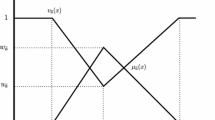Abstract
A linear Diophantine fuzzy number (LDFN), by incorporating reference parameters (RPs), provides freedom to the decision makers in evaluating and analyzing the objects initially by membership and non-membership grades. The RPs provide an additional evaluation to these grades. LDFNs can express uncertain cognitive information in multi-criteria decision-making (MCDM) approach. To examine the uncertain cognition in MCDM and to improve interrelationship among criterion, we introduce aggregation operators named as linear Diophantine fuzzy Choquet integral aggregation (LDFCIA) operator and generalized linear Diophantine fuzzy Choquet integral aggregation (GLDFCIA) operators. Additionally, we associate the notion of \(L^p\)-spaces to GLDFCIA operators and extend them towards project management and risk analysis. A pre-chart based on the fuzzy interval [0, 1] to classify the types and stages of risk factors in project management is developed. To distinguish the most exquisite and successful project as well as to reduce the risk factors emerging in the project management, an innovative algorithm based on LDFNs, GLDFCIA operators, score functions LDFNs and max–min composition is constructed. Moreover, we examine the role of parameter “p” in GLDFCIA operators to facilitate decision-makers (DMs) to classify the symmetry of optimal decision, identification of risk factors, and reduction of risk factors in the project development schemes. The study reveals that by chosen a suitable AO as per the choice of the expert, it will provide a wide range of compromise solutions for the decision-maker.







Similar content being viewed by others
Data availability
The data used to support the findings of the study are included with in the article.
References
Abdollahi MB, Ghezelbash H, Eskandari M (2012) The application of project management. Int J Sci Eng Investig 1(7):5–12
Ahmmad J, Mahmood T, Chinram R, Iampan A (2021) Some average aggregation operators based on spherical fuzzy soft sets and their applications in multi-criteria decision making. AIMS Math 6(7):7798–7832
Ahmad S, Basharat P, Abdullah S, Botmart T, Jirawattanapanit A (2022) MABAC under non-linear diophantine fuzzy numbers: a new approach for emergency decision support systems. AIMS Math 7(10):17699–17736
Alcantud JCR (2022) The relationship between fuzzy soft and soft topologies. J Intell Fuzzy Syst. https://doi.org/10.1007/s40815-021-01225-4
Ali MI (2018) Another view on q-rung orthopair fuzzy sets. Int J Intell Syst 33:2139–2153
Alidi AS (1996) Use of an analytic hierarchy process to measure the initial viability of industrial projects. Int J Project Mang 14(4):205–208
Almagrabi AO, Abdullah S, Shams M, Al-Otaibi YD, Ashraf S (2022) A new approach to q-linear Diophantine fuzzy emergency decision support system for COVID19. J Ambient Intell Human Comput 13:1687–1713
Ashraf S, Abdullah S, Mahmood T, Ghani F, Mahmood T (2019) Spherical fuzzy sets and their applications in multi-attribute decision making problems. J Intell Fuzzy Syst 36(3):2829–2844
Ashraf S, Razzaque H, Naeem M, Botmart T (2023) Spherical q-linear Diophantine fuzzy aggregation information: Application in decision support systems. AIMS Math 8(3):6651–6681
Atanassov KT (1984) Intuitionistic fuzzy sets. In: Sgurev V (ed) VII ITKRs Session, Sofia, June 1983. Central Sci. and Techn. Library, Bulg. Academy of Sciences, Baku
Chen SM, Tan MJ (1994) Handling multicriteria fuzzy decision-makling problems based on vague set theory. Fuzzy Sets Syst 67:163–172
Choquet G (1954) Theory of capaities. Ann De L’Inst Fourier 5:131–295
Cuong BC (2014) Picture fuzzy sets. J Comput Sci Cybern 30(4):409–420
Deli I, Ali M, Smarandache F (2015) Bipolar neutrosophic sets and their application based on multi-criteria decision-making problems. In: Proceedings of 2015 international conference on advanced mechatronic systems, Beijing, China
Dodangeh J, Mojahed M, Yusuff RBM (2009) Best project selection by using of group TOPSIS method. In: Proceedings of international association of computer science and information technology (IACSIT-SC’ 09). pp 50–53
Farid HMA, Riaz M (2021) Some generalized q-rung orthopair fuzzy Einstein interactive geometric aggregation operators with improved operational laws. Int J Intell Syst 36:7239–7273
Farid HMA, Riaz M (2023) q-rung orthopair fuzzy Aczel–Alsina aggregation operators with multi-criteria decision-making. Eng Appl Artif Intell 122:106105
Feng F, Jun YB, Liu X, Li L (2010) An adjustable approach to fuzzy soft set based decision making. J Comput Appl Math 234(1):10–20
Feng F, Fujita H, Ali MI, Yager RR, Liu X (2019) Another view on generalized intuitionistic fuzzy soft sets and related multi-attribute decision-making methods. IEEE Trans Fuzzy Syst 27(3):474–488
Garg H (2016a) A new generalized Pythagorean fuzzy information aggregation using Einstein operations and its application to decision making. Int J Intell Syst 31(9):886–920
Garg H (2016b) Generalized intuitionistic fuzzy interactive geometric interaction operators using Einstein t-norm and t-conorm and their application to decision making. Comput Ind Eng 101:53–69
Gül S, Aydogdu A (2023) Novel distance and entropy definitions for linear Diophantine fuzzy sets and an extension of TOPSIS (LDF-TOPSIS). Expert Syst 40(1):e13104
Gundogdu FK, Kahraman C (2019) Spherical fuzzy sets and spherical fuzzy TOPSIS method. J Intell Fuzzy Syst 36(1):337–352
Halouani N, Chabchoub H, Martel JM (2009) PROMETHEE-MD-2T method for project selection. Eur J Oper Res 195(3):841–849
Jacas CRG, Leyva LC, Ponce YM, Lezcano JS, Guzmán FC, Meriño MP, Reyes RV (2018) Choquet integral based fuzzy molecular characterizations:when global definitions are computed from the dependency among atom/bond contributions (LOVIs/LOEIs). J Cheminform 10(51):1–17
Jana C, Senapati T, Pal M, Yager RR (2019a) Picture fuzzy Dombi aggregation operators: application to MADM process. Appl Soft Comput 74:99–109
Jana C, Senapati T, Pal M, Yager RR (2019b) Picture fuzzy Dombi aggregation operators: application to MADM process. Appl Soft Comput 74:99–109
Jana C, Garg H, Pal M (2022) Multi-attribute decision making for power Dombi operators under Pythagorean fuzzy information with MABAC method. J Ambient Intell Hum Comput. https://doi.org/10.1007/s12652-022-04348-0
Jia Z, Zhang Y (2019) Interval-valued intuitionistic fuzzy multiple attribute group decision-making with uncertain weightes. Math Probl Eng 1–9
Jose S, Kuriaskose S (2014) Aggregation operators, score function and accuracy function for multi criteria decision making in intuitionistic fuzzy context. Notes Instuit Fuzzy Sets 20(1):40–44
Kamaci H (2021) Linguistic single-valued neutrosophic soft sets with applications in game theory. Int J Intell Syst 36:3917–3960
Kamaci H (2022) Complex linear Diophantine fuzzy sets and their cosine similarity measures with applications. Complex Intell Syst 8:1281–1305
Karaaslan F, Ozlu S (2020) Correlation coefficients of dual type-2 hesitant fuzzy sets and their applications in clustering analysis. Int J Intell Syst 35(4):1200–1229
Karczmarek P, Kiersztyn A, Pedrycz W (2018) Generalized Choquet integral for face recognition. Int J Fuzzy Syst 20(3):1047–1055
Kwak YH (2005) A brief history of project management. In: Carayannis EG et al (eds) The story of managing projects. Greenwood Publishing Group, Westport (ISBN 1-56720-506-2)
Li X, Zhang X, Park C (2018) Generalized interval neutrosophic Choquet aggregation operators and their applications. Symmetry 10(85):1–17
Mahmood T, Ur Rehman U (2022) A novel approach towards bipolar complex fuzzy sets and their applications in generalized similarity measures. Int J Intell Syst 37(1):535–567
Mahmoodzadeh S, Shahrabi J, Pariazar M, Zaeri MS (2007) Project selection by using fuzzy AHP and TOPSIS technique. Int J Hum Soc Sci 1(3):333–338
Mohanty R (1992) Project selection by a multiple-criteria decision-making method: an example from a developing country. Int J Project Manag 10(1):31–38
Narayanamoorthy S, Brainy J, Sulaiman R, Ferrara M, Ahmadian A, Kang D (2022) An integrated decision making approach for selecting a sustainable waste water treatment technology. Chemosphere 301:134568
Olivier M (2017) Project feasibility - tools for uncovering points of vulnerability. Taylor and Francis, CRC Press, New York, p 546
Paul TK, Jana C, Pal M, Simic V (2022) Sustainable carbon-dioxide storage assessment in geological media using modified Pythagorean fuzzy VIKOR and DEMATEL approach. Int J Hydrogen Energy. https://doi.org/10.1016/j.ijhydene.2022.12.024
Peng X, Garg H (2018) Algorithms for interval-valued fuzzy soft sets in emergency decision-making based on WDBA and CODAS with new information measure. Comput Ind Eng 119:439–452
Peng X, Yang Y (2015) Some results for Pythagorean fuzzy sets. Int J Intell Syst 30:1133–1160
Riaz M, Farid HMA (2022) Hierarchical medical diagnosis approach for COVID-19 based on picture fuzzy fairly aggregation operators. Int J Biomath. https://doi.org/10.1142/S1793524522500759
Riaz M, Hashmi MR (2019) Linear Diophantine fuzzy set and its applications towards multi-attribute decision making problems. J Intell Fuzzy Syst 37(4):5417–5439
Riaz M, Farid HMA, Wang W, Pamucar D (2022) Interval-valued linear Diophantine fuzzy frank aggregation operators with multi-criteria decision-making. Mathematics 10:1811
Riesz F (1910) Untersuchungen über Systeme integrierbarer Funktionen. Math Ann 69(4):449–497
Rouyendegh BD (2012) Evaluating projects based on intuitionistic fuzzy group decision-making. J Appl Math. https://doi.org/10.1155/2012/824265
Saha A, Dutta D, Kar S (2021a) Some new hybrid hesitant fuzzy weighted aggregation operators based on Archimedean and Dombi operations for multi-attribute decision making. Neural Comput Appl 33(14):8753–8776
Saha A, Majumder P, Dutta D, Debnath BK (2021b) Multi-attribute decision making using q-rung orthopair fuzzy weighted fairly aggregation operators. J Ambient Intell Hum Comput 12(7):8149–8171
Senapati T, Yager RR (2019) Fermatean fuzzy weighted averaging/geometric operators and its application in multi-criteria decision-making methods. Eng Appl Artif Intell 85:112–121
Shaheen T, Ali MI, Toor H (2021) Why do we need q-rung orthopair fuzzy sets? Some evidence established via mass assignment. Int J Intell Syst. https://doi.org/10.1002/int.22520
Smarandache F (1998) Neutrosophy neutrosophic probability, set and logic. American Research Press, Rehoboth
Smarandache F (1999) A unifying field in logics: neutrosophic logic. Neutrosophy, neutrosophic set, neutrosophic probability and statistics, second, third, fourth respectively fifth. American Research Press, Rehoboth, pp 1–155 (2000, 2005, 2006)
Sugeno M (1975) Theory of fuzzy integral and its applications, Ph.D. Thesis, Tokyo Institute of Technology, Tokyo, Japan
Sun HX, Yang HX, Wu JZ, Ouyang Y (2015) Interval neutrosophic numbers Choquet integral operator for multi-criteria decision-making. J Intell Fuzzy Syst 28:2443–2455
Tahani H, Keller JM (1990) Information fusion in computer vision using the fuzzy integral. IEEE Trans Syst Man Cybern 20(3):733–741
Tan C (2011) A multi-criteria interval-valued intuitionistic fuzzy group decision making with Choquet integral-based TOPSIS. Expert Syst Appl 38(4):3023–3033
Tan C, Chen X (2010) Intuitionistic fuzzy Choquet integral operator for multi-criteria decision-making. Expert Syst Appl 37(1):149–157
Tversky A, Kahneman D (1992) Advances in prospect theory: cumulative representation of uncertainity. J Risk Uncertain 5:297–323
Wang L, Zhang HY, Wang JQ, Wu GF (2020) Picture fuzzy multi-criteria group decision-making method to hotel building energy efficiency retrofit project selection. RAIRO-Oper Res 54:211–229
Wei GW (2018) Picture fuzzy hamacher aggregation operators and their application to multiple attribute decision making. Fund Inform 157(3):271–320
Xu Z (2007) Intuitionistic fuzzy aggregation operators. IEEE Trans Fuzzy Syst 15(6):1179–1187
Xu Z, Xia M (2011) On distance and correlation measures of hesitant fuzzy information. Int J Intell Syst 26(5):410–425
Yager RR (2014) Pythagorean membership grades in multi criteria decision-making. IEEE Trans Fuzzy Syst 22:958–965
Yager RR (2017) Generalized orthopair fuzzy sets. IEEE Trans Fuzzy Syst 25:1222–1230
Yang Z, Ouyang T, Fu X, Peng X (2020) A decision-making algorithm for online shopping using deep-learning-based opinion pairs mining and q-rung orthopair fuzzy interaction Heronian mean operators. Int J Intell Syst 35(5):783–825
Zadeh LA (1965) Fuzzy sets. Inf Control 8:338–353
Zadeh LA (1975) The concept of a linguistic variable and its application to approximate reasoning-I. Inf Sci 8(3):199–249
Zhang WR (1994) Bipolar fuzzy sets and relations: a computational framework for cognitive modeling and multiagent decision analysis, NAFIPS/IFIS/NASA94. In: Proceedings of the first international joint conference of the North American fuzzy information processing society biannual conference. The Industrial Fuzzy Control and Intellige, pp 305–309
Zhang XL, Xu ZS (2014) Extension of TOPSIS to multiple criteria decision making with Pythagorean fuzzy sets. Int J Intell Syst 29:1061–1078
Zhao S, Wang D, Changyong L, Lu W (2019) Induced Choquet integral aggregation operators with single-valued neutrosophic uncertain linguistic numbers and their applications in multiple-attribute group decision-making. Math Probl Eng. https://doi.org/10.1155/2019/9143624
Author information
Authors and Affiliations
Contributions
All authors contributed equally in this research paper.
Corresponding author
Ethics declarations
conflict of interest
The authors declare no conflict of interest.
Additional information
Communicated by Leonardo Tomazeli Duarte.
Publisher's Note
Springer Nature remains neutral with regard to jurisdictional claims in published maps and institutional affiliations.
Appendix
Appendix
Proof of Theorem 4:
We prove this result by using Mathematical induction. For \(q=1\) the the result obtained directly from Definition 3.3. Now we check it for \(q=2\). The Eq. (3) for \(q=2\) can be represented as
So Eq. (4) is true for \(q=2\). Now we suppose that it is true for \(q=z\) and prove that it holds for \(q=z+1\). For \(q=z\) we can write it as
For \(q=z+1\)
This implies that Eq. (4) is true for \(q=z+1\). \(\square \)
Rights and permissions
Springer Nature or its licensor (e.g. a society or other partner) holds exclusive rights to this article under a publishing agreement with the author(s) or other rightsholder(s); author self-archiving of the accepted manuscript version of this article is solely governed by the terms of such publishing agreement and applicable law.
About this article
Cite this article
Riaz, M., Garg, H., Hashmi, M.R. et al. Generalized linear diophantine fuzzy Choquet integral with application to the project management and risk analysis. Comp. Appl. Math. 42, 286 (2023). https://doi.org/10.1007/s40314-023-02421-8
Received:
Revised:
Accepted:
Published:
DOI: https://doi.org/10.1007/s40314-023-02421-8
Keywords
- Linear Diophantine fuzzy number (LDFN)
- LDF-Choquet integral aggregation (LDFCIA) operator
- Generalized LDF-Choquet integral aggregation (GLDFCIA) operators
- Max–min composition
- Project management
- Risk analysis
- MCDM




